Are you thinking of adding a Fittonia plant to your home, but you have a cat? You may be wondering if Fittonia is toxic to cats.
Before bringing this beautiful, unique houseplant into your living space, it’s important to know the answer.
Fittonia is an eye-catching plant with pink, white or green leaves and red veins running through them.
It’s also known as a nerve plant due to its intricate leaf patterns.
This low-maintenance plant can thrive in indirect sunlight and needs regular watering. No wonder it’s become so popular.
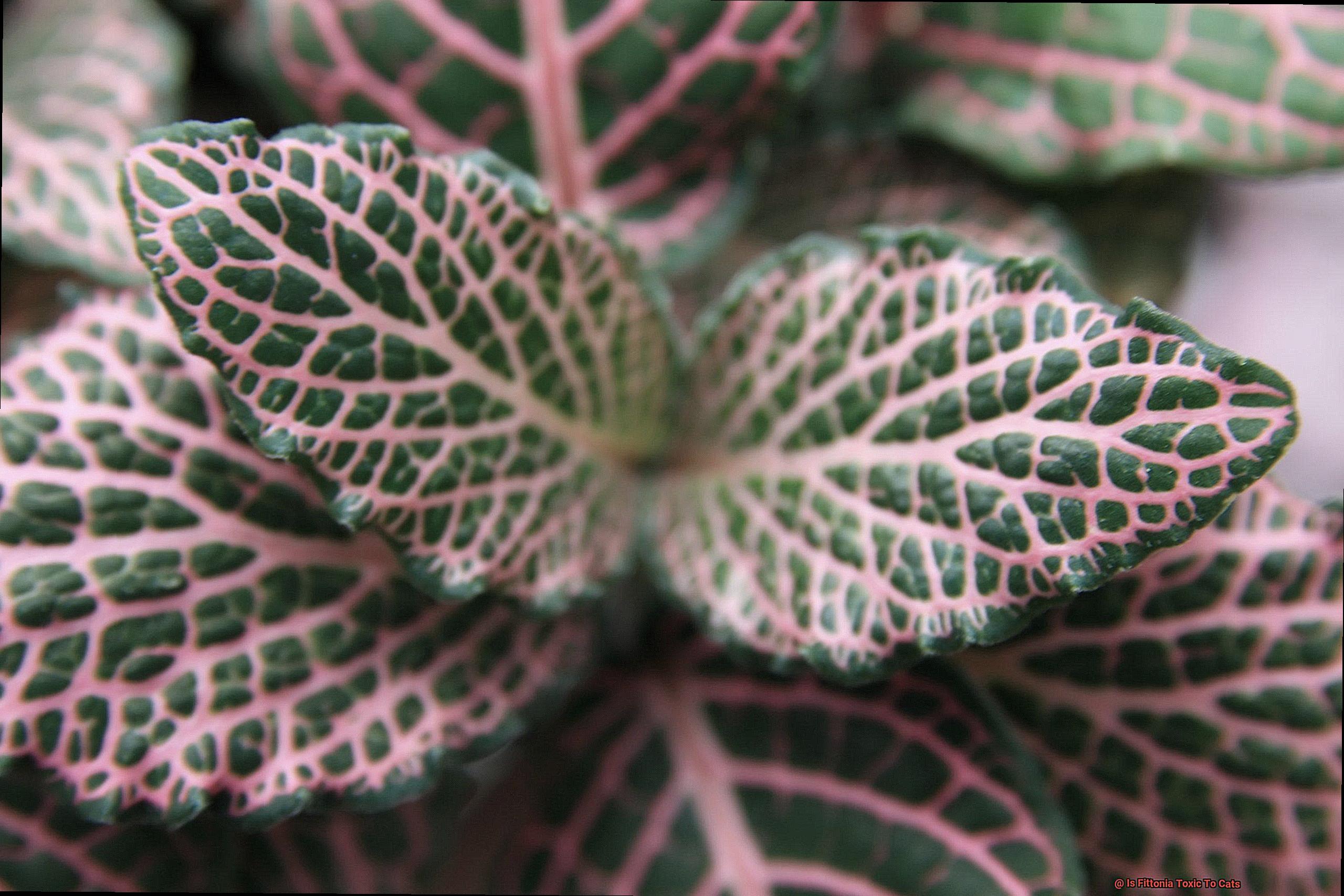
Fittonia isn’t harmful to cats. However, there are some precautions you should take when caring for this plant around cats.
Fittonia contains saponins which can cause digestive upset if ingested by cats.
Its leaves can also irritate their skin and eyes if they come into contact with them.
To keep your cat safe, don’t let them eat any parts of the plant or come into contact with it often.
Place the Fittonia in an area that’s out of reach from curious cats, if possible.
What Are The Symptoms Of Fittonia Poisoning In Cats?
Fittonia poisoning in cats is a serious matter that requires immediate attention.
If your feline friend has come into contact with the plant, there are certain symptoms to watch out for.
These include vomiting, diarrhea, lethargy, loss of appetite, drooling, and difficulty breathing.
In more severe cases, seizures, coma and even death may occur.
Don’t hesitate to contact your veterinarian if you suspect your cat has been poisoned by Fittonia or any other plant – acting quickly can mean the difference between life and death.
How To Keep Cats Away From Fittonia?
With the right techniques, it is possible to keep cats away from Fittonia.
Here are some tips and tricks to help keep your Fittonia safe and sound.
First, use a physical barrier such as a fence or screen to block cats from getting too close to the plant. If this isn’t an option, then planting Fittonia in an area that is not easily accessible to cats, like a hanging basket or on a high shelf, can also be beneficial.
Next, deter cats from attacking the plant by spraying citrus-scented spray or cayenne pepper around it. Citrus peels can also make it less attractive to cats. Additionally, planting cat repellent plants such as lavender, rue and pennyroyal near Fittonia may discourage cats from approaching it.
Lastly, using motion detectors that emit an ultrasonic sound when triggered by cat movement near the plant can help keep them away.
Is Fittonia Red Toxic To Cats?
Fittonia Red may be the perfect choice for you. This beautiful plant has a unique foliage pattern that will add an eye-catching touch to any room.
But is Fittonia Red toxic to cats?
The saponins embedded in its leaves are the main irritant in Fittonia red.
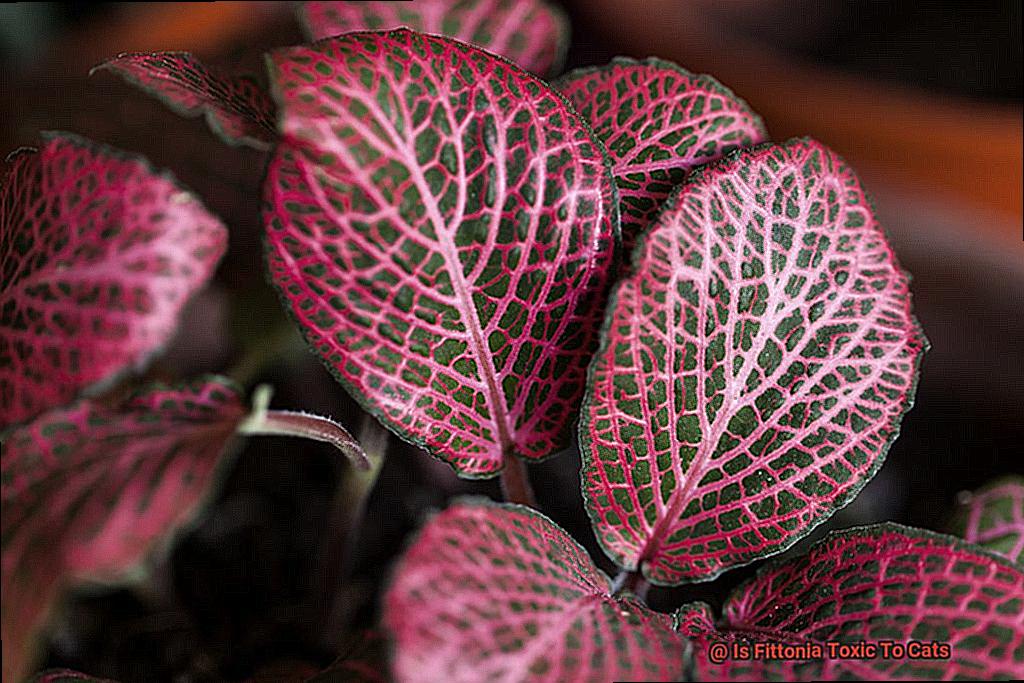
If ingested by cats, these saponins can cause skin irritation, vomiting and diarrhea.
While Fittonia red may not be toxic to cats, it is still best to keep them away from the plant as they may suffer from its saponins’ irritation.
So, if you are considering adding this stunning houseplant to your home, keep in mind that it is important to keep your cats away from it.

Although it is not toxic, the saponins contained in the plant’s leaves can still cause irritation if ingested by cats.
The Most Common Types of Fittonia Plants
Fittonia plants are a stunning and vibrant addition to any home.
Native to South America’s tropical regions, these plants have become popular houseplants due to their attractive foliage and easy care.
Three of the most common Fittonia plants are Fittonia albivenis, Fittonia argyroneura, and Fittonia verschaffeltii.
Fittonia aliveness has white veins on a dark green background; the Fittonia argyroneura has silver veins on a medium green background; and the Fittonia verschaffeltii has pink veins on a light green background.
These colors make them an ideal choice for terrariums or as ground cover in warm climates.
Caring for Fittonia plants is simple.
They need indirect sunlight, daily watering to keep the soil moist but not soggy, and fertilizing every few months with a balanced fertilizer to keep them healthy.
If you’re looking for an eye-catching houseplant that adds life to any room, then look no further than Fittonia plants. They are easy to maintain and will be sure to brighten up your space.
How To Identify If Your Cat Has Eaten Fittonia
Fittonia is a common houseplant that can be found in many households and gardens around the world.
Unfortunately, cats can become seriously ill if they ingest large amounts of this plant.
If you suspect your cat has eaten Fittonia, it’s important to be aware of the potential signs of poisoning and take action quickly.
- The first step in determining if your cat has eaten fittonia is to look for signs of ingestion. Check the area around your cat’s food dish for any bits of the plant, as well as any tell-tale signs that your cat may have been nibbling on it. If you find any evidence of fittonia in the vicinity, your cat has likely eaten some.
- The second step is to observe your cat’s behavior. If your cat appears to be lethargic or unwell, this could be a sign that they have ingested fittonia. Additionally, if your cat is exhibiting signs of nausea or vomiting, this could also indicate that they have eaten the plant.
- Finally, you should take your cat to the vet for a check-up if you suspect they have eaten fittonia. Your vet will be able to perform tests to confirm whether or not your cat has ingested the plant and provide advice on how to treat them. Additionally, they can provide advice on how to prevent your cat from eating fittonia in the future.
Signs of Fittonia Poisoning in Cats
The most common signs of Fittonia toxicity in cats are vomiting, diarrhea, drooling, loss of appetite, and lethargy.
If you notice any of these symptoms in your cat, it is essential to take them to the vet right away for a diagnosis and treatment plan.
Diagnosis and Treatment Options
After taking your cat to the vet for a checkup, they will likely run tests to determine if Fittonia poisoning is present.
These tests may include a physical exam, blood work, and/or an x-ray.
The vet may also administer activated charcoal to absorb any toxins that are still in the stomach or intestines.
Treatment for Fittonia poisoning will depend on the severity of the symptoms and may include intravenous fluids, medication to reduce vomiting and nausea, or even surgery in extreme cases.
Types Of Fittonia
It’s important to note that there are several species of this plant with different degrees of toxicity; some species have more toxins than others; it’s best to figure out which type you have before allowing your cat access to it.
In addition, make sure not to use fertilizer or potting soil with fertilizer on this plant because doing so will also raise the plant’s toxicity level.
What Should You Do If Your Cat Has Eaten Fittonia?
If your cat has eaten fittonia, it is essential to act fast. Fittonia poisoning can be deadly for cats and can cause vomiting, diarrhea, and difficulty breathing.
If you observe any of these symptoms in your feline friend, contact your veterinarian immediately.
To reduce the absorption of toxins, your vet may suggest inducing vomiting or giving them activated charcoal.
Depending on the severity of the case, hospitalization may be required for additional treatment.
Keep your cat safe by removing all sources of fittonia from its environment and making sure that all other plants in your home are pet-friendly.
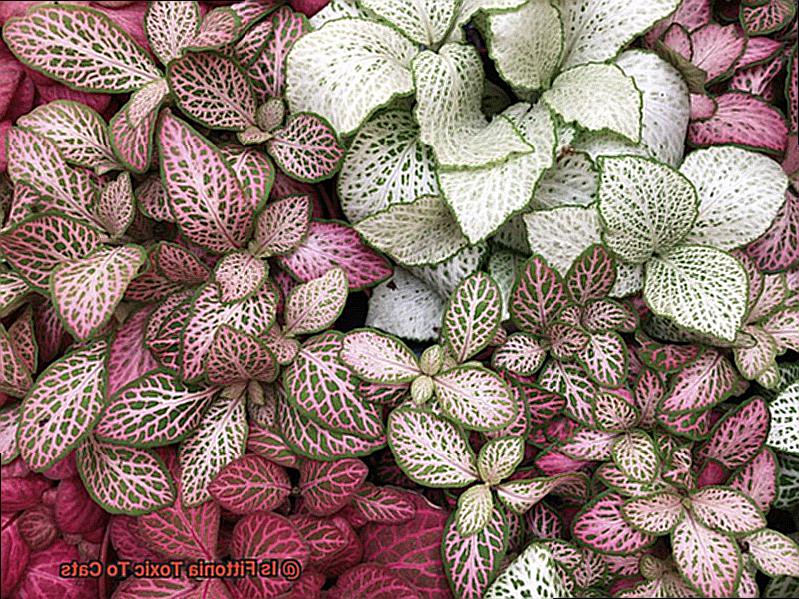
Don’t delay – get help for your furry companion as soon as possible.
Seeking Veterinary Care
If your cat has eaten Fittonia or has been exposed to its chemicals in any way, it is vital to seek veterinary attention immediately.
Depending on their findings, your veterinarian will be able to determine your cat’s health and recommend appropriate treatment options.
They may also have tips on how to prevent future events like this one from happening again so that your pet stays safe and healthy at all times.
How Can You Prevent Your Cat From Eating Fittonia?
Having a cat and a Fittonia plant in the same household can be a challenge.
After all, cats love to explore and nibble on plants, but Fittonia is toxic for them.
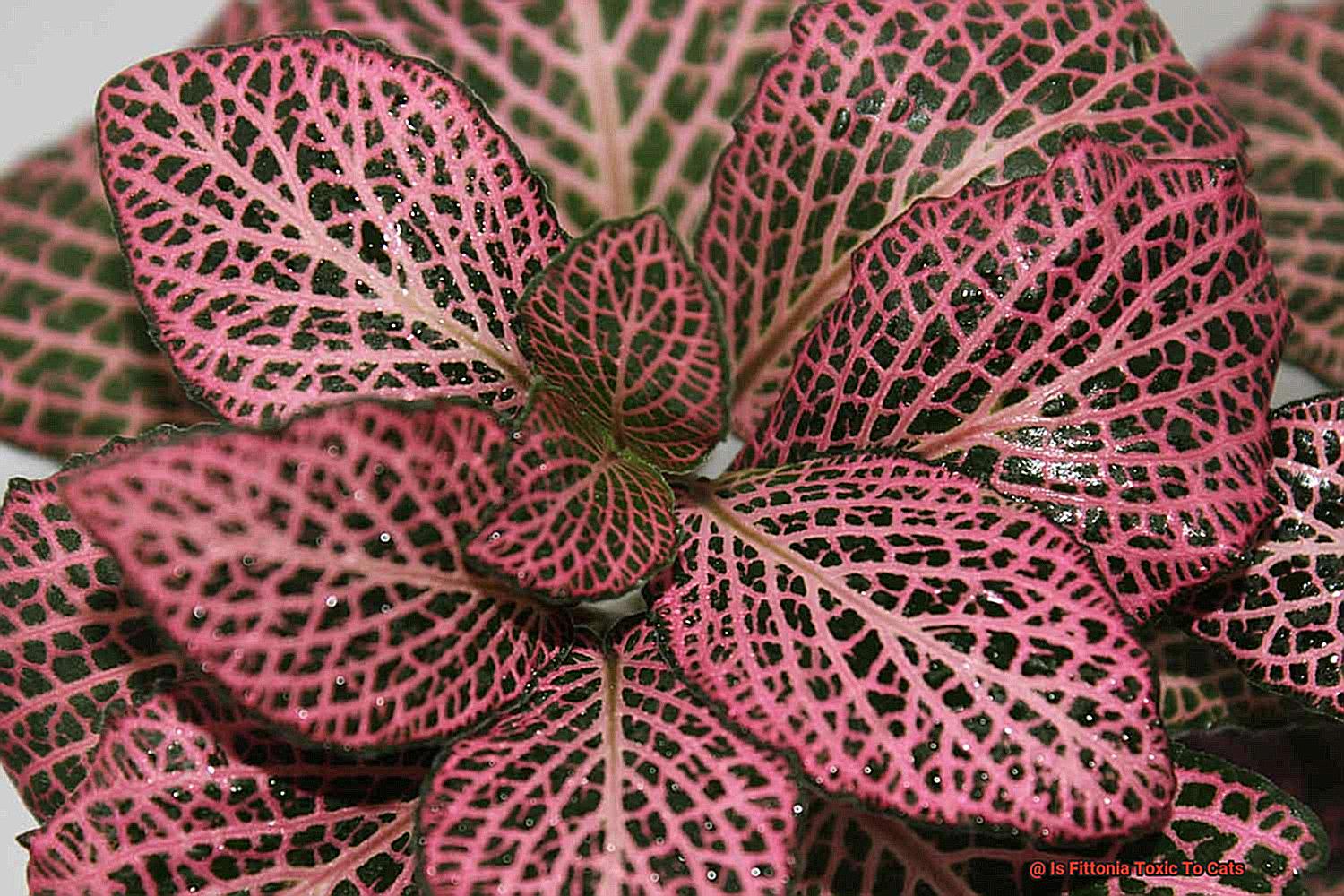
If you want to keep your furry friend safe and your Fittonia intact, here are some tips to prevent your cat from eating it.
First of all, keep the plant out of reach.
Place it in a room that is inaccessible to cats or use a physical barrier such as a fence or screen around the plant.
Make sure the pot is secure so that cats can’t knock it over or chew on it.

You can also provide plenty of interesting toys and activities for your cat to occupy its time and make them less likely to be attracted to the Fittonia plant.
If you have multiple cats, monitor them when they’re near the Fittonia plant to make sure they don’t try to eat it or play with it too much.
Lastly, consider using natural deterrents such as citrus scents or cayenne pepper mixed with water and sprayed around the tree.
This will help cats stay away from the Fittonia without hurting them.
Alternatives to Fittonia For Pet Owners
Are you a pet owner looking for alternatives to Fittonia? If so, you’ve come to the right place.
Fittonia is a gorgeous plant, but unfortunately, it can be poisonous to cats and other animals.
Fortunately, there are plenty of alternatives that are safe for your furry friends.
Chinese Evergreen, Spider Plant, Snake Plant, and Philodendron are all excellent options for pet owners.
These plants add a touch of beauty to any room in your home with their lush foliage and vibrant colors.
Plus, they are non-toxic and don’t require much care.
These alternatives to Fittonia offer numerous benefits that make them preferable over the original plant.
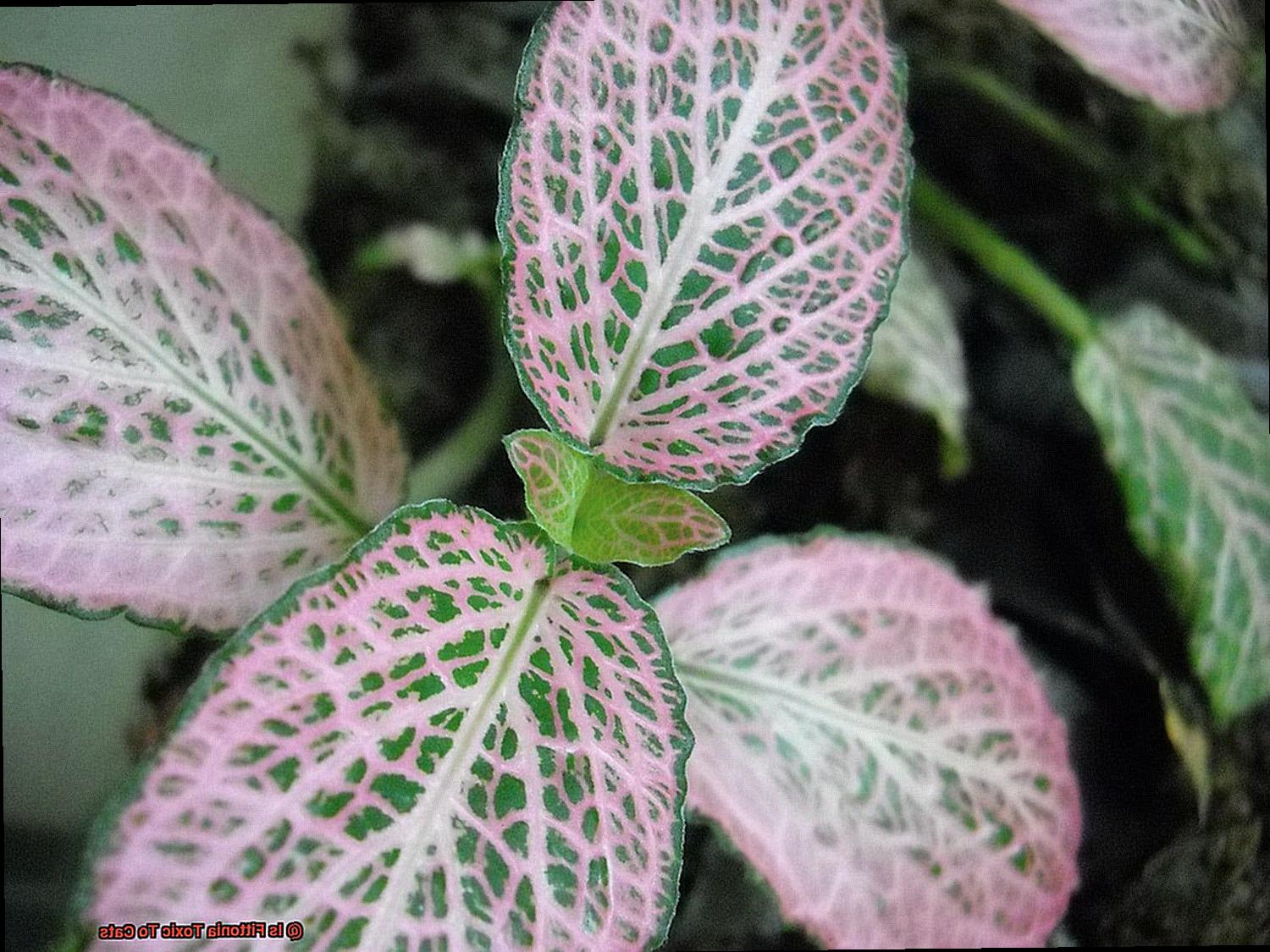
Not only do they have stunning aesthetics without the risk of toxicity, but they also require minimal maintenance.
To keep cats away from Fittonia, it’s important to make sure that the plant is out of reach or in an area where cats cannot access it easily.
So, there are plenty of alternatives to Fittonia that are safe for pet owners.
With their stunning beauty and low-maintenance requirements, these plants will bring life into your home without putting your furry friends in danger.
Conclusion
When it comes to having a pet and a houseplant in the same household, it’s essential to ensure both are safe.
Fittonia is an attractive plant with intricate leaf patterns, but if ingested or touched by cats, it can be fatal.
Fortunately, there are plenty of alternatives for pet owners who want to enjoy the beauty of this plant without putting their furry friends in danger.
For pet owners looking for non-toxic plants, the Chinese Evergreen, Spider Plant, Snake Plant and Philodendron are excellent options.
Not only do they have a stunning appearance, but they also require little upkeep.
To keep cats away from Fittonia, make sure that the plant is out of reach or in an area where cats can’t access it easily.
Fittonia is an elegant addition to any home – just make sure you take the necessary precautions.







